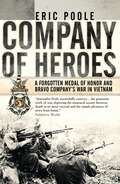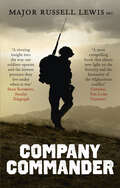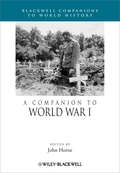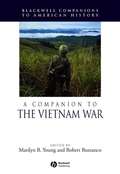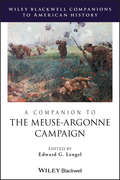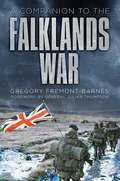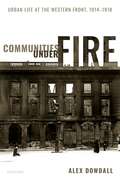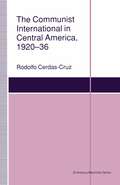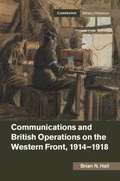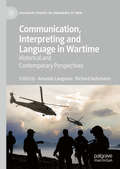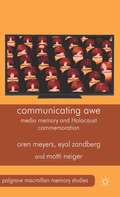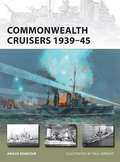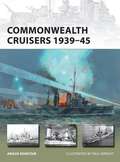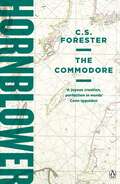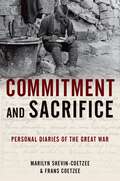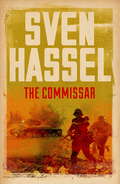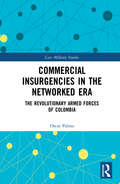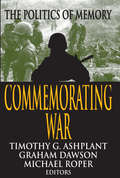- Table View
- List View
Company of Heroes: A Forgotten Medal of Honor and Bravo Company’s War in Vietnam
by Eric PooleThere are many broad studies of the Vietnam War, but this work offers an insight into the harrowing experiences of just a small number of men from a single unit, deep in the jungles of Vietnam and Cambodia. Its focus is the remarkable account of a Medal of Honor recipient Leslie Sabo Jr., whose brave actions were forgotten for over three decades. Sabo and other replacement soldiers in Bravo Company, 3rd Battalion, 506th Infantry (Currahees), 101st Airborne Division, were involved in intense, bloody engagements such as the battle for Hill 474 and the Mother's Day Ambush. Beginning with their deployment at the height of the blistering Tet Offensive, and using military records and interviews with surviving soldiers, Eric Poole recreates the terror of combat amidst the jungles and rice paddies of Vietnam. Company of Heroes, now published in paperback tells the remarkable story of how Sabo earned his medal, as Bravo Company forged bonds of brotherhood in their daily battle for survival.
Company Commander
by Russell LewisIn 2008 Major Russell Lewis commanded a company of two hundred soldiers from the British Army's legendary Parachute Regiment on a six-month tour in the most dangerous part of Afghanistan.Company Commander is his story, a riveting first-person account of incredible bravery, telling what it is like to have 200 Paras depending on you constantly, to make decisions which can and do cost lives, to see men under your command killed and injured and being under the most intense pressure imaginable every minute of every day for six long months.Company Commander is a true leader's story – a unique and vivid mix of front-line battles and strategic decision making and an intensely personal and inspiring account of a tour in the most perilous theatre of war on the planet.
A Companion to World War I (Wiley Blackwell Companions to World History #25)
by John HorneA Companion to the First World War brings together an international team of distinguished historians who provide a series of original and thought-provoking essays on one of the most devastating events in modern history. Comprises 38 essays by leading scholars who analyze the current state of historical scholarship on the First World War Provides extensive coverage spanning the pre-war period, the military conflict, social, economic, political, and cultural developments, and the war's legacy Offers original perspectives on themes as diverse as strategy and tactics, war crimes, science and technology, and the arts Selected as a 2011 Outstanding Academic Title by CHOICE
A Companion to World War I (Wiley Blackwell Companions to World History)
by John HorneA Companion to the First World War brings together an international team of distinguished historians who provide a series of original and thought-provoking essays on one of the most devastating events in modern history. Comprises 38 essays by leading scholars who analyze the current state of historical scholarship on the First World War Provides extensive coverage spanning the pre-war period, the military conflict, social, economic, political, and cultural developments, and the war's legacy Offers original perspectives on themes as diverse as strategy and tactics, war crimes, science and technology, and the arts Selected as a 2011 Outstanding Academic Title by CHOICE
A Companion to the Vietnam War (Wiley Blackwell Companions to American History)
by Marilyn B. Young Robert BuzzancoA Companion to the Vietnam War contains twenty-four definitive essays on America's longest and most divisive foreign conflict. It represents the best current scholarship on this controversial and influential episode in modern American history. Highlights issues of nationalism, culture, gender, and race. Covers the breadth of Vietnam War history, including American war policies, the Vietnamese perspective, the antiwar movement, and the American home front. Surveys and evaluates the best scholarship on every important era and topic. Includes a select bibliography to guide further research.
A Companion to the Meuse-Argonne Campaign (Wiley Blackwell Companions to American History)
by Edward G. LengelA Companion to the Meuse-Argonne Campaign explores the single largest and bloodiest battle in American military history, including its many controversies, in historiographical essays that reflect the current state of the field. Presents original essays on the French and German participation in ‒ and perspectives on ‒ this important event Makes use of original archival research from the United States, France, and Germany Contributors include WWI scholars from France, Germany, the United States, and the United Kingdom Essays examine the military, social, and political consequences of the Meuse-Argonne and points the way for future scholarship in this area
A Companion to the Meuse-Argonne Campaign (Wiley Blackwell Companions to American History)
by Edward G. LengelA Companion to the Meuse-Argonne Campaign explores the single largest and bloodiest battle in American military history, including its many controversies, in historiographical essays that reflect the current state of the field. Presents original essays on the French and German participation in ‒ and perspectives on ‒ this important event Makes use of original archival research from the United States, France, and Germany Contributors include WWI scholars from France, Germany, the United States, and the United Kingdom Essays examine the military, social, and political consequences of the Meuse-Argonne and points the way for future scholarship in this area
A Companion to the Falklands War
by Gregory Fremont-BarnesThe Falklands War is a story of occupation, fierce air battles, heavy naval losses and bitter encounters between ground forces amidst an inhospitable terrain and unforgiving climate. With complex political machinations and nationalist sentiment at the centre of the conflict, even today the sovereignty of the islands is hotly contested in political circles. For the first time, renowned military historian Gregory Fremont-Barnes has compiled a definitive A–Z guide to the British involvement in the Falklands conflict, including personalities, weapons, battles, ships, places and much more. This accessible yet comprehensive companion to the Falklands War will be a welcome addition to any enthusiast’s shelves.
A Companion to American Military History (Wiley Blackwell Companions to American History #45)
by James C. BradfordWith more than 60 essays, A Companion to American Military History presents a comprehensive analysis of the historiography of United States military history from the colonial era to the present. Covers the entire spectrum of US history from the Indian and imperial conflicts of the seventeenth century to the battles in Afghanistan and Iraq Features an unprecedented breadth of coverage from eminent military historians and emerging scholars, including little studied topics such as the military and music, military ethics, care of the dead, and sports Surveys and evaluates the best scholarship on every important era and topic Summarizes current debates and identifies areas where conflicting interpretations are in need of further study
Communities under Fire: Urban Life at the Western Front, 1914-1918
by Alex DowdallBetween 1914 and 1918, the Western Front passed through some of Europe's most populated and industrialised regions. Large towns including Nancy, Reims, Arras, and Lens lay at the heart of the battlefield. Their civilian inhabitants endured artillery bombardment, military occupation, and material hardship. Many fled for the safety of the French interior, but others lived under fire for much of the war, ensuring the Western Front remained a joint civil-military space. Communities under Fire explores the wartime experiences of civilians on both sides of the Western Front, and uncovers how urban communities responded to the dramatic impact of industrialized war. It discusses how war shaped civilians' personal and collective identities, and explores how the experiences of military violence, occupation, and forced displacement structured the attitudes of civilians at the front towards the rest of the nation. Drawing on a vast array of archival sources, letters, diaries, and newspapers in English, French, and German, it reveals the history of the Western Front from the perspective of its civilian inhabitants. From Leningrad to Warsaw, Hamburg, and, more recently, Sarajevo and Donetsk, urban violence has remained a feature of warfare in Europe, turning cities into battlefields. On each occasion, civilian populations were at the heart of military operations, and forced to adapt to life in a warzone. This was also the case between 1914 and 1918, despite the myth that the First World War was predominantly a soldiers' war. The civilian inhabitants of the Western Front were among the first to suffer the full impact of modern, industrialized war in an urban setting. Communities under Fire explains the multiple ways by which these urban residents responded to, were changed by, succumbed to, or survived the enormous pressures of life in a warzone.
Communities under Fire: Urban Life at the Western Front, 1914-1918
by Alex DowdallBetween 1914 and 1918, the Western Front passed through some of Europe's most populated and industrialised regions. Large towns including Nancy, Reims, Arras, and Lens lay at the heart of the battlefield. Their civilian inhabitants endured artillery bombardment, military occupation, and material hardship. Many fled for the safety of the French interior, but others lived under fire for much of the war, ensuring the Western Front remained a joint civil-military space. Communities under Fire explores the wartime experiences of civilians on both sides of the Western Front, and uncovers how urban communities responded to the dramatic impact of industrialized war. It discusses how war shaped civilians' personal and collective identities, and explores how the experiences of military violence, occupation, and forced displacement structured the attitudes of civilians at the front towards the rest of the nation. Drawing on a vast array of archival sources, letters, diaries, and newspapers in English, French, and German, it reveals the history of the Western Front from the perspective of its civilian inhabitants. From Leningrad to Warsaw, Hamburg, and, more recently, Sarajevo and Donetsk, urban violence has remained a feature of warfare in Europe, turning cities into battlefields. On each occasion, civilian populations were at the heart of military operations, and forced to adapt to life in a warzone. This was also the case between 1914 and 1918, despite the myth that the First World War was predominantly a soldiers' war. The civilian inhabitants of the Western Front were among the first to suffer the full impact of modern, industrialized war in an urban setting. Communities under Fire explains the multiple ways by which these urban residents responded to, were changed by, succumbed to, or survived the enormous pressures of life in a warzone.
The Communist International in Central America, 1920–36 (St Antony's Series)
by Rodolfo Cerdaz-CruzA report on the activities of the Komintern in the Isthmus in a crucial period of time. Cerdas-Cruz discusses the debates, reports and resolutions adopted by that organization on such issues as the revolution and its character, and the Party and its nature.
Communications and British Operations on the Western Front, 1914-1918 (Cambridge Military Histories Ser.)
by Brian N. HallThis is an important new study examining the military operations of the British Expeditionary Force in 1914–18 through the lens of its communications system. Brian Hall charts how new communications technology such as wireless, telephone and telegraph were used alongside visual signalling, carrier pigeons and runners as the British army struggled to develop a communication system adequate enough to wage modern warfare. He reveals how tenuous communications added to the difficulties of command and control during the war's early years, and examines their role during the major battles of the Somme, Arras, Ypres and Cambrai. It was only in 1918 that the British army would finally develop a flexible and sophisticated communications system capable of effectively coordinating infantry, artillery, tanks and aeroplanes. This is a major contribution to our understanding of British military operations during the First World War, the learning processes of armies and the revolution in military affairs.
Communication, Interpreting and Language in Wartime: Historical and Contemporary Perspectives (Palgrave Studies in Languages at War)
by Amanda Laugesen Richard GehrmannThis edited book provides a multi-disciplinary approach to the topics of translation and cross-cultural communication in times of war and conflict. It examines the historical and contemporary experiences of interpreters in war and in war crimes trials, as well as considering policy issues in communication difficulties in war-related contexts. The range of perspectives incorporated in this volume will appeal to scholars, practitioners and policy-makers, particularly in the fields of translating and interpreting, conflict and war studies, and military history.
Communicating Awe: Media Memory and Holocaust Commemoration (Palgrave Macmillan Memory Studies)
by O. Meyers M. Neiger E. ZandbergOffering a cross-media exploration of Israeli media on Holocaust Remembrance Day, one of Israel's most sacred national rituals, over the past six decades, this fascinating book investigates the way in which variables such as medium, structure of ownership, genre and targeted audiences shape the collective recollection of traumatic memories.
Commonwealth Cruisers 1939–45 (New Vanguard #226)
by Angus Konstam Mr Paul WrightIn the early 20th century Britain's largest colonies established their own small naval presence, and their ships fought alongside the Royal Navy during World War I. These fleets were expanded during the inter-war years, and in 1939 the Royal Australian Navy, the Royal Canadian Navy and the Royal New Zealand Navy willingly joined the fight on behalf of the British Commonwealth. For the most part these small navies consisted of a few cruisers and destroyers, designed to protect territorial waters and local sea lanes. However, these warships and their crews soon found themselves involved in a global war, and consequently were called upon to fight wherever they were needed, against the Germans, the Italians and the Japanese. This book tells the story of these small cruiser forces, and the men who served the Allied cause so well during the long and brutal war at sea.
Commonwealth Cruisers 1939–45 (New Vanguard)
by Paul Wright Angus KonstamIn the early 20th century Britain's largest colonies established their own small naval presence, and their ships fought alongside the Royal Navy during World War I. These fleets were expanded during the inter-war years, and in 1939 the Royal Australian Navy, the Royal Canadian Navy and the Royal New Zealand Navy willingly joined the fight on behalf of the British Commonwealth. For the most part these small navies consisted of a few cruisers and destroyers, designed to protect territorial waters and local sea lanes. However, these warships and their crews soon found themselves involved in a global war, and consequently were called upon to fight wherever they were needed, against the Germans, the Italians and the Japanese. This book tells the story of these small cruiser forces, and the men who served the Allied cause so well during the long and brutal war at sea.
The Commodore: Flying Colours, The Commodore, Lord Hornblower, Hornblower In The West Indies (A Horatio Hornblower Tale of the Sea #9)
by C. S. Forester1812 and the fate of Europe lies in the hands of newly appointed Commodore Hornblower . . . Dispatched to northern waters to protect Britain's Baltic interests, Horatio Hornblower must halt the advance of Napoleon's empire into Sweden and Russia. But first he must battle the terrible Baltic weather: fog, snow and icebound waterways; overcome Russian political and commercial intrigues; avoid the seductive charms of royalty as well as the deadly reach of assassins in the imperial palace; and contend with hostile armies and French privateers. With the fate of Europe balanced on a knife edge, the responsibility lies heavy on a Commodore's shoulders . . .This is the eighth of eleven books chronicling the adventures of C. S. Forester's inimitable nautical hero, Horatio Hornblower.
Commitment and Sacrifice: Personal Diaries from the Great War
by Marilyn Shevin-Coetzee Frans CoetzeeFor years, those who attempted to understand the devastation of World War I looked to the collections of diplomatic documents, the stirring speeches, and the partisan memoirs of the leading participants. However, those accounts offered little by way of the intimate history, or the individual experiences of those involved in the Great War. In Commitment and Sacrifice, Marilyn Shevin-Coetzee and Frans Coetzee provide just such an "intimate look" by bringing together previously unpublished diaries of five participants in the First World War and restoring to publication the diary of a sixth that has long been out of print. The six diaries address the war on the Western front and the Mediterranean, as well as behind the lines on the home front. Together, these diarists form a diverse group: John French, a British sapper who dug precarious tunnels beneath the trenches of the Western Front; Henri Desagneaux, a French infantry officer embroiled in years of bloody combat; Philip T. Cate, an idealistic American volunteer ambulance driver who sought to save lives rather than take them; Willy Wolff, a German businessman caught in England upon the war's outbreak and interned there for the duration; James Douglas Hutchison, a New Zealand artilleryman fighting thousands of miles from home; and Felix Kaufmann, a German machine gunner, captured and held as a prisoner of war. Through the personal reflections of these young men, we are transported into many of the iconic episodes of the war, from the upheaval of mobilization through the great battles of Gallipoli, Verdun, and the Somme, as well as the less familiar "other ordeal" of internment and captivity. As members of the so-called Generation of 1914 (each was between nineteen and twenty-four years old), they shared an unwavering commitment to their countries' cause, and possessed a steadfast determination to persevere despite often appalling circumstances. Collectively, these diaries illuminate the sacrifices of war, whether willingly volunteered or stoically endured. That the diarists had the desire and the ingenuity to record their experiences, whether for their families, posterity, or simply their own personal satisfaction, gives readers the ability to eavesdrop on horrors long past. A century later, we are fortunate that they were both willing and able to set pencil to paper.
Commitment and Sacrifice: Personal Diaries from the Great War
by Marilyn Shevin-Coetzee Frans CoetzeeFor years, those who attempted to understand the devastation of World War I looked to the collections of diplomatic documents, the stirring speeches, and the partisan memoirs of the leading participants. However, those accounts offered little by way of the intimate history, or the individual experiences of those involved in the Great War. In Commitment and Sacrifice, Marilyn Shevin-Coetzee and Frans Coetzee provide just such an "intimate look" by bringing together previously unpublished diaries of five participants in the First World War and restoring to publication the diary of a sixth that has long been out of print. The six diaries address the war on the Western front and the Mediterranean, as well as behind the lines on the home front. Together, these diarists form a diverse group: John French, a British sapper who dug precarious tunnels beneath the trenches of the Western Front; Henri Desagneaux, a French infantry officer embroiled in years of bloody combat; Philip T. Cate, an idealistic American volunteer ambulance driver who sought to save lives rather than take them; Willy Wolff, a German businessman caught in England upon the war's outbreak and interned there for the duration; James Douglas Hutchison, a New Zealand artilleryman fighting thousands of miles from home; and Felix Kaufmann, a German machine gunner, captured and held as a prisoner of war. Through the personal reflections of these young men, we are transported into many of the iconic episodes of the war, from the upheaval of mobilization through the great battles of Gallipoli, Verdun, and the Somme, as well as the less familiar "other ordeal" of internment and captivity. As members of the so-called Generation of 1914 (each was between nineteen and twenty-four years old), they shared an unwavering commitment to their countries' cause, and possessed a steadfast determination to persevere despite often appalling circumstances. Collectively, these diaries illuminate the sacrifices of war, whether willingly volunteered or stoically endured. That the diarists had the desire and the ingenuity to record their experiences, whether for their families, posterity, or simply their own personal satisfaction, gives readers the ability to eavesdrop on horrors long past. A century later, we are fortunate that they were both willing and able to set pencil to paper.
The Commissar (Sven Hassel War Classics)
by Sven HasselA shocking insight into the brutalities faced by ordinary soldiers and the atrocities committed in the name of survival.Dispassionately we stared at the bloody scene. It had become an everyday sight. The 27th Penal Regiment care nothing for Hitler's war. They fight only to stay alive. But then they uncover the Soviet Army's biggest secret. A Russian commissar has hidden 30 million dollars of gold somewhere behind enemy lines. In a madcap scheme, Porta brokers a deal with the commissar: free passage for the Russians in return for a share of the gold. To find it, Sven and his comrades must be prepared to lie, steal and go behind the lines of the deadly Russian army...
Commercial Insurgencies in the Networked Era: The Revolutionary Armed Forces of Colombia (Cass Military Studies)
by Oscar PalmaThis book examines the Revolutionary Armed Forces of Colombia (FARC) as a commercial insurgency through the network-complex paradigm of insurgency. Countering traditional perspectives of the group, it proposes new and comprehensive explanations for the FARC’s presence in Latin America. Existing narratives have portrayed the FARC as a terrorist, narco-terrorist, or criminal organization – a narrative popularized by the government offensive conducted by the Colombian state during the last couple of decades. In contrast, this book goes beyond simplistic perspectives of the FARC and instead studies the group in relation to the network-complex paradigm of insurgency. It explains the organization as a ‘commercial insurgency’ with three dimensions – political, criminal, and military – and understands the Colombian insurgency not as a monolith, but as a system of individuals with diversified interests ranging from the highly indoctrinated to the profit-motivated. This examination allows for an analysis of some of the insurgency’s most unexplored characteristics: an interest in urbanizing its actions and the increased ‘invisibility’ of combatants, the significance of its political institutions, and the construction of its transnational networks. The volume also discusses the future of FARC in post-conflict Colombia, not only within the country but as an actor in the region. This work will be of much interest to students of insurgencies, military studies, Latin American studies, criminology, security studies, and IR.
Commercial Insurgencies in the Networked Era: The Revolutionary Armed Forces of Colombia (Cass Military Studies)
by Oscar PalmaThis book examines the Revolutionary Armed Forces of Colombia (FARC) as a commercial insurgency through the network-complex paradigm of insurgency. Countering traditional perspectives of the group, it proposes new and comprehensive explanations for the FARC’s presence in Latin America. Existing narratives have portrayed the FARC as a terrorist, narco-terrorist, or criminal organization – a narrative popularized by the government offensive conducted by the Colombian state during the last couple of decades. In contrast, this book goes beyond simplistic perspectives of the FARC and instead studies the group in relation to the network-complex paradigm of insurgency. It explains the organization as a ‘commercial insurgency’ with three dimensions – political, criminal, and military – and understands the Colombian insurgency not as a monolith, but as a system of individuals with diversified interests ranging from the highly indoctrinated to the profit-motivated. This examination allows for an analysis of some of the insurgency’s most unexplored characteristics: an interest in urbanizing its actions and the increased ‘invisibility’ of combatants, the significance of its political institutions, and the construction of its transnational networks. The volume also discusses the future of FARC in post-conflict Colombia, not only within the country but as an actor in the region. This work will be of much interest to students of insurgencies, military studies, Latin American studies, criminology, security studies, and IR.
Commemorating War: The Politics of Memory
by Graham DawsonWar memory and commemoration have had increasingly high profiles in public and academic debates in recent years. This volume examines some of the social changes that have led to this development, among them the passing of the two world wars from survivor into cultural memory. Focusing on the politics of war memory and commemoration, the book illuminates the struggle to install particular memories at the center of a cultural world, and offers an extensive argument about how the politics of commemoration practices should be understood.Commemorating War analyzes a range of forms of remembrance, from public commemorations orchestrated by nation-states to personal testimonies of war survivors; and from cultural memories of war represented in films, plays and novels to investigations of wartime atrocities in courts of human rights. It presents a wide range of international case studies, encompassing lesser-known national histories and wars beyond the well-trodden terrain of Vietnam and the two world wars in Europe.Emerging from this book is an important critique of both "state-centered" approaches to war memory and those that regard commemoration primarily as a human response to loss and grief. Offering a wealth of empirical research material, this book will be important for cultural and oral historians, sociologists, researchers in international relations and human rights, and anybody with an interest in the cultural construction of memory in contemporary society.
Commemorating War: The Politics of Memory
by Timothy G. Ash Plant Graham DawsonWar memory and commemoration have had increasingly high profiles in public and academic debates in recent years. This volume examines some of the social changes that have led to this development, among them the passing of the two world wars from survivor into cultural memory. Focusing on the politics of war memory and commemoration, the book illuminates the struggle to install particular memories at the center of a cultural world, and offers an extensive argument about how the politics of commemoration practices should be understood.Commemorating War analyzes a range of forms of remembrance, from public commemorations orchestrated by nation-states to personal testimonies of war survivors; and from cultural memories of war represented in films, plays and novels to investigations of wartime atrocities in courts of human rights. It presents a wide range of international case studies, encompassing lesser-known national histories and wars beyond the well-trodden terrain of Vietnam and the two world wars in Europe.Emerging from this book is an important critique of both "state-centered" approaches to war memory and those that regard commemoration primarily as a human response to loss and grief. Offering a wealth of empirical research material, this book will be important for cultural and oral historians, sociologists, researchers in international relations and human rights, and anybody with an interest in the cultural construction of memory in contemporary society.
